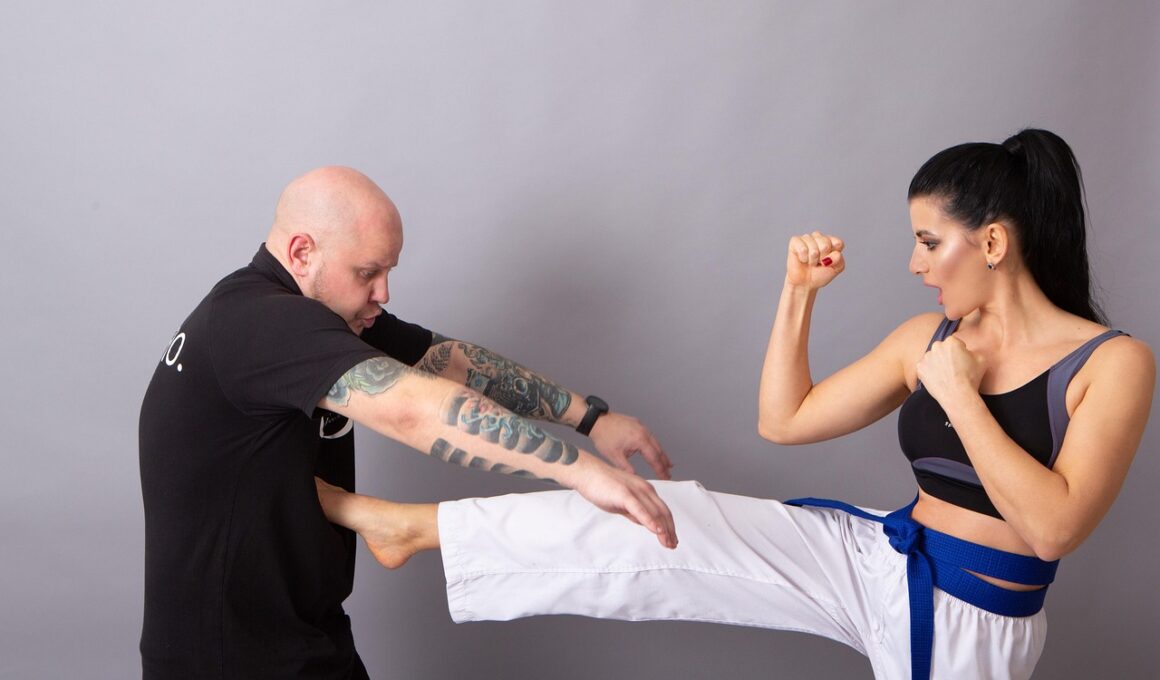Karate and Self-Defense: Using Techniques in Real-Life Situations
Karate is not just a sport; it is an effective self-defense technique. Understanding how to apply martial arts techniques in real-life situations can significantly enhance your personal safety. Learning Karate equips individuals with the skills to react quickly in various scenarios. The discipline focuses on honing physical strength, agility, and mental sharpness. Training sessions improve reflexes, allowing practitioners to respond effectively to potential threats. Additionally, Karate promotes awareness of surroundings, a crucial aspect of self-defense. Knowing how to protect oneself boosts confidence, creating a more empowered individual. This empowerment extends beyond physical self-defense. The principles learned in Karate can help in conflict resolution and stress management. Self-defense is a mindset, and Karate cultivates a state of readiness to engage or disengage effectively. Regular practice also builds endurance, strength, and flexibility. These physical advantages prepare practitioners to handle confrontations more efficiently. Other benefits of Karate include heightened self-esteem and discipline, contributing to overall life satisfaction. Incorporating Karate into your routine can transform your approach to personal safety and self-reliance, ultimately making life more secure and fulfilling.
Using Karate techniques in real-life situations involves mastering essential skills that have practical applications. Techniques such as blocks, strikes, and stances serve as effective tools against potential attackers. Practitioners learn how to defend against various threats, both verbal and physical. Understanding distance and timing is paramount in self-defense; Karate teaches these principles through repetitive training. For example, learning how to gauge an opponent’s reach enables you to strike from a safe distance while maintaining control. Moreover, Karate emphasizes the importance of using minimal force necessary to mitigate a threat. Stillness of the mind through meditation techniques enhances focus during altercations. This mental clarity allows Karate practitioners to evaluate threats calmly. Furthermore, engaging in sparring sessions helps simulate real-life confrontations, providing valuable experience. These sessions enhance adaptability and speed, which are crucial when facing unexpected scenarios. It is essential to understand that while Karate can be an effective self-defense tool, de-escalation should always be the first approach. The goal is to avoid physical confrontation whenever possible, fostering peaceful resolutions in stressful situations. Ultimately, Karate instills principles that empower individuals to respond wisely and effectively should self-defense become necessary.
Essential Techniques for Self-Defense
In Karate, specific techniques are particularly effective for self-defense situations. Learning how to execute basic strikes, such as punches and kicks, can provide the necessary edge to escape challenging scenarios. For instance, a well-placed front kick can create distance between you and an attacker, buying you precious time. Additionally, techniques like the side block are vital for deflecting incoming strikes and neutralizing threats. Practicing these techniques in a controlled environment enhances muscle memory, making them instinctual. Transferring this knowledge to real-life situations is integral to effectiveness. Incorporating basic joint locks can also disarm an aggressor, leveraging their strength against them. Furthermore, counters and evasions are essential components of Karate training. Knowing how to move in unpredictable ways helps minimize the possibility of being hit. Training in combination strikes ensures that you can respond fluidly to an attack. It is also helpful to practice situational awareness, recognizing potential dangers before they escalate into physical confrontations. Regular training builds the agility necessary to evade attacks and respond quickly. Overall, mastering these techniques positions Karate practitioners favorably in challenging situations, equipping them with problem-solving skills when every second counts.
In real-life self-defense scenarios, defense is just as crucial as striking techniques. Karate emphasizes defensive maneuvers to minimize the potential of harm while disengaging. Techniques such as the backfist and low block are essential for intercepting an attacker’s moves effectively. Practicing these defensive techniques builds confidence and develops rapid reflexes. Countering an attack with a swift maneuver not only protects you but also positions you for a counters strike. Moreover, controlling the aggressor’s movements through grappling holds offers another layer of self-defense. Grappling techniques teach how to maintain composure and leverage for disablement. Engaging in defense drills during training prepares students for real-life unpredictability, reinforcing the principles of fluidity and adaptability. It’s also important to highlight situational tactics, such as creating an escape route during an altercation. Practitioners learn that self-defense is not solely about winning; it’s about ensuring personal safety. The foundational ideology of Karate promotes self-preservation over confrontation. Utilizing defensive techniques conserves energy and maximizes effectiveness, further solidifying the self-defense concepts rooted within Karate. The principles instilled by consistent practice prepare individuals not just physically, but also mentally for potential confrontations.
Mental Preparation for Self-Defense
Besides physical training, mental preparation is a significant component of real-life self-defense using Karate. Cultivating a warrior mentality allows individuals to approach potentially threatening situations with composure and strategy. Mental resilience reduces panic, enabling more effective decision-making. Being calm during adversity is crucial, and techniques such as visualization can help prepare for real-life confrontations. Envisioning various scenarios allows practitioners to mentally rehearse responses to potential threats, reinforcing confidence. Furthermore, the discipline learned through Karate training fosters perseverance and grit, valuable assets in unpredictable situations. Practicing mindfulness can also heighten awareness of surroundings, essential for identifying potential threats early. Techniques that involve meditation can aid in developing emotional control, allowing individuals to respond rather than react during altercations. Emphasizing a proactive mindset forms the core of effective self-defense. Practitioners should constantly evaluate their surroundings, creating a mental toolkit for quick responses. Employing these mental strategies alongside physical techniques creates a holistic approach to self-defense training. Ultimately, the objective is to empower oneself fully, merging physical capabilities with a resolute mental state for optimal preparation against real-life threats.
Assessing the environment is vital for integrating Karate techniques into self-defense. Awareness of surroundings can help recognize hazardous situations before they escalate. Practitioners learn to observe body language and environmental cues, informing their responses. For instance, if someone appears aggressive in demeanor, maintaining distance is crucial—they may be a potential threat. The use of peripheral vision enables Karate students to stay alert to movements around them. Training drills often incorporate situational awareness exercises, honing observational skills crucial for everyday safety. Karate practitioners are also taught to trust their instincts; gut feelings can provide crucial insights into potential dangers. In addition, understanding the importance of escape routes whenever venturing into uncertain environments can greatly enhance personal safety; knowing where to go can be invaluable. Visualizing exit plans creates a safety net during emergencies. This analytical approach to self-defense highlights that awareness is often the best defense. Engaging in conversations about personal safety strengthens community connections and promotes safety awareness. In scenarios that escalate unexpectedly, there’s immense value in being informed. Fostering a culture of safety within karate teaches practitioners to respect their personal safety and that of others.
Conclusion: The Lifelong Journey of Karate
In conclusion, Karate is a lifelong journey towards mastering self-defense techniques applicable in real-life situations. It equips individuals with both physical skills and mental fortitude essential for escaping dangerous scenarios. Throughout the training process, practitioners cultivate discipline, awareness, and resilience. These qualities extend beyond physical confrontations, enhancing overall personal growth and interactions with others. Students learn to embody the spirit of Karate, integrating its principles into daily life. The core values of respect, patience, and perseverance become cornerstones for navigating challenges. Continual practice leads to refinement of skills, ensuring readiness in case of confrontations. It is also crucial to remember that effective self-defense prioritizes prevention and de-escalation, emphasizing non-violent approaches first. Building confidence through Karate fosters a mindset that values personal safety. Engaging within the martial arts community also encourages shared responsibility toward self-defense education. Ultimately, practicing Karate enables individuals to defend themselves and cultivate a sense of community. This practice enhances life satisfaction, contributing to total well-being. The experience of mastering techniques empowers each individual, solidifying the benefits of Karate into everyday existence, ensuring enhanced personal security.
Using Karate techniques in real-life situations involves mastering essential skills that have practical applications. Techniques such as blocks, strikes, and stances serve as effective tools against potential attackers. Practitioners learn how to defend against various threats, both verbal and physical. Understanding distance and timing is paramount in self-defense; Karate teaches these principles through repetitive training. For example, learning how to gauge an opponent’s reach enables you to strike from a safe distance while maintaining control. Moreover, Karate emphasizes the importance of using the minimal force necessary to mitigate a threat. Stillness of the mind through meditation techniques enhances focus during altercations. This mental clarity allows Karate practitioners to evaluate threats calmly. Furthermore, engaging in sparring sessions helps simulate real-life confrontations, providing valuable experience. These sessions enhance adaptability and speed, which are crucial when facing unexpected scenarios. It is essential to understand that while Karate can be an effective self-defense tool, de-escalation should always be the first approach. The goal is to avoid physical confrontation whenever possible, fostering peaceful resolutions in stressful situations. Ultimately, Karate instills principles that empower individuals to respond wisely and effectively should self-defense become necessary.


